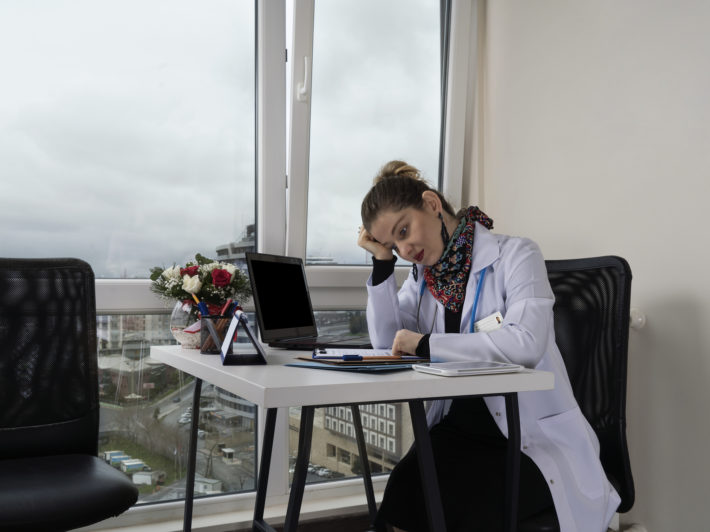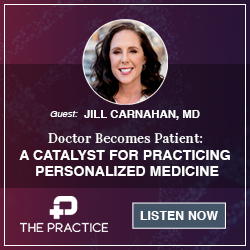
by Sara Gottfried, MD
Physician burnout and suicide rates are alarmingly high.1 Some blame the two hours of charting in an electronic health record (EHR) for every hour of patient care.2-3 Others cite the rushed 7.5-minute patient appointment that limits the delivery of high-quality care.4 Numerous challenges coexist: an aging population, the rising burden of chronic disease, billing requirements, workforce shortages (particularly in primary care), increasing health disparities, and shifting healthcare policies. Many physicians feel disempowered and hopeless about the state of modern medicine. Regardless of cause, one thing is certain: We are desperately in need of change in our broken healthcare system.
The following perspective is a sobering excerpt from a JAMA publication from over 40 years ago (1977):5 “Psychological barriers in the minds of the failing physician, his/her family, and colleagues may thwart prevention of physician-suicide. The failing physician may be shunned by colleagues for his/her disturbed behavior. He/she denies illness, resorts to self-medication, and avoids treatment. Recognition and rational handling of this presuicidal state may be hindered by the need of the doctor, family, and colleagues to preserve a fantasy of the doctor’s omnipotence.”
Fast forward to present day, and the situation is unfortunately no less dire. According to a 2018 JAMA study, 45% of medical residents report symptoms of physician burnout.6 In the same study, 14% of these doctors regretted their career choice.6 As physicians increased in burnout symptoms, so did their thoughts of suicide and medical errors.6 A 2009 study in JAMA found that roughly 50% of hospitalized patients suffer from a medical error made from a doctor experiencing burnout symptoms.7 Short version: The situation is dire in the current mainstream medical system. How do we protect the health of the professionals who protect our own? Disruption and solutions are desperately needed.
“Of all occupations and professions, the medical profession consistently hovers near the top of occupations with the highest risk of death by suicide.”8 And female physicians are more vulnerable. A 2018 report on physician burnout described the suicide rate of doctors as being 1.4-2.3 times higher for men and 2.5-4 times higher for women, when compared to the general population.8 Another report on physician burnout found that female physicians experience higher burnout rates (near 50%) than their male counterparts.1 The report hypothesizes that women may be more affected because they are more likely to admit and seek help for psychological problems, often receive less pay for equal work, and are disproportionately burdened by childcare and other familial responsibilities.1
Classic signs and symptoms of burnout not only include psychological factors but also physiological and functional impairments:9
- Emotional exhaustion
- Depersonalization (may manifest as cynicism)
- Feelings of inefficacy and diminished personal accomplishment
- Sleep disturbances
- Reduced work performance
- Chronic pain (migraines, tension headaches, abdominal pain)
- Changes in biomarkers involving the hypothalamic-pituitary-adrenal (HPA) axis, hormones, autonomic nervous system, immune system, and metabolic pathways, though consensus is lacking
Read more about the psychological diagnosis of burnout in the Maslach Burnout Inventory (MBI), a validated survey and useful assessment tool for burnout.9
“Burn-out” is in fact included as an occupational phenomenon (not a medical condition) in the International Classification of Diseases (ICD) under code QD85, with the ICD-11 recently (in May 2019) providing an updated, more detailed definition: “Burn-out is a syndrome conceptualized as resulting from chronic workplace stress that has not been successfully managed.”10 Furthermore, three defined factors characterize this burn-out syndrome, including:10
- “Feelings of energy depletion or exhaustion;
- Increased mental distance from one’s job, or feelings or negativism or cynicism related to one’s job; and
- Reduced professional efficacy”
Researching physician burnout comes with certain challenges. A 2018 JAMA systemic review pointed to several problems with studying physician burnout—primarily that the condition is poorly defined and inconsistencies in the definition make it difficult to know the true severity or find solutions.11 Hence, physician burnout is turning into a medical epidemic that is poorly understood, all the while seriously affecting our doctors and the patients they treat. Physician burnout is complex and not a moral failing on the part of the clinician, but rather the exhaustion of adaptive techniques inside a broken medical system.
Although physician burnout and suicide are not new problems, their prevalence and far-reaching consequences have reached critical levels and can no longer be ignored. Several leading healthcare organizations recently declared physician burnout a “public health crisis,”12 and published a report titled, “A Crisis in Healthcare: A Call to Action on Physician Burnout,” which includes directives aimed at attenuating burnout in physicians and other healthcare providers.13
In this article, I hope to arm the physician with tools to continue providing compassionate care, to increase career satisfaction and contentment, and to help heal the wounds inflicted by a demanding work environment. Of course, burnout doesn’t just affect medical doctors. Nurses, nurse practitioners, physician assistants, and most other allied health professionals are also at risk. Outside of medicine, teachers, daycare workers, and emergency responders are at high risk of burnout. As clinicians interested in a personalized approach to medicine, there is clear value in treating the symptoms while concurrently architecting the conditions for robust health—in ourselves, and in the greater healthcare system.
A 3-step solution to survive and mitigate burnout:
1. Identify and correct maladaptive coping strategies and problematic components of your work.
As doctors, we all know there are healthy and unhealthy ways of addressing the problems we face. According to the Medscape National Physician Burnout, Depression, and Suicide Report,1 isolating from others (41%), eating junk food (32%), drinking alcohol (23%), and binge eating (19%) were common dysfunctional coping mechanisms among physicians. Luckily, many of us also use methods that improve our situation like exercising (48%), talking with friends and family (43%), and playing or listening to music (33%).1 Though behavioral changes can be difficult to implement, consider your coping mechanisms and favor those that better your circumstances in the long term.
In a 2015 randomized controlled trial (RCT), researchers explored if biweekly one-hour discussion groups with fellow physicians, along with elements of mindfulness for 9 months, would be an effective way of combating burnout.14 As a control, they compared against physicians who were given one-hour paid breaks and also followed a non-study cohort of physicians. The experimental (peer-discussion/mindfulness) group demonstrated significant reductions in emotional exhaustion and depersonalization, as well as higher levels of work engagement, though other measures were unaffected.14 The authors posit that physicians who agreed to participate may have been more likely to experience higher levels of burnout, which may have affected their results. These findings suggest that breaking the silence of frustrations with work and work-life balance could be therapeutic. And that’s important since physicians report much lower work-life integration than other working US adults.15 Even if you’re not experiencing burnout, if you invited two of your colleagues out for a cup of coffee, a hike, or to come over for dinner, you’d likely be benefiting at least one of them.
A 2017 RCT looked at the use of medical scribes during patient visits to create chart note and fill out paperwork.16 The results were remarkable. From the physicians assigned to having a scribe, the results indicated an overall increased satisfaction with the clinic (odds ratio [OR]: 10.75), as well as having enough face time with their patients (OR: 3.71) and with time spent charting (OR: 86.09); chart accuracy also significantly increased (OR 4.61), which spells direct benefit for patient care and safety.16
2. Start or strengthen your contemplative practice.
If you don’t already have a contemplative practice, now is a good time to start. The purpose is to observe your thoughts and reactions with some level of objectivity, known in mind-body medicine as developing the witness. In several studies looking at interventions for burnout, mindfulness meditation provided significant benefits.14,17 In a 2017 RCT study of 44 interns in an Australian hospital, participants were randomized to either an extra hour break (control) or mindfulness training program for 10 weeks.17 Participants in the mindfulness intervention reported significantly greater improvements in stress and burnout symptoms.17
Meditation, especially mindfulness, brings you to full awareness of the current moment. By making expectations obsolete, mindfulness reduces the suffering of your mind’s resistance to your current conditions. This is not to say you will be in a state of bliss or joy, but that you will reframe your experiences and see them in a more accurate, less judgmental way.
Meditation is a powerful exercise, and the benefits compound with frequent, regular practice. When you are more mindful, you are more present with your patients. They likely pick up on your level of attentiveness and engagement and respond to your compassion in a way that brings greater meaning to your work.
It has been suggested that burnout has links to post-traumatic stress disorder (PTSD).18 A 2018 study in veterans with PTSD examined the effects of twice-daily diaphragmatic breathing using a breath pacer paired with heart-rate variability training and found significant benefit in PTSD symptoms.19 You can also find breath pacers to practice breathing techniques, which will increase your ability to regulate your autonomic nervous system.
3. Incorporate herbs that can help manage stress.
Herbs that fall into the category of “adaptogens” can be especially helpful for someone experiencing burnout. These herbs can curb your response to stress, combating fatigue, depression, anxiety, and cognitive deficits often encountered when working under stressful conditions.20
Panax ginseng is a root herb with a long history in traditional Chinese medicine (TCM). Its anti-stress properties are thought to be attributed to effects on the hypothalamic-pituitary-adrenal (HPA) axis.21 Clinical studies demonstrate that Panax ginseng can improve working memory performance, attention, and reaction times in healthy adults.20,22-23 Panax ginseng may positively impact glucose levels in diabetics by improving insulin sensitivity; however, close monitoring is advised in people prone to hypoglycemia.24 In general, limit its use to six months or less. A typical dosage of Panax ginseng when taken as a single herb is 150-400 mg daily.
Rhodiola rosea is another adaptogenic herb that has positive effects on both mood and mental fatigue.20 Clinical research shows that rhodiola can significantly reduce symptoms of mild-to-moderate depression such as irritability and sleep problems, but it does not seem to have a significant effect on feelings of self-esteem.25 Rhodiola has also been studied to reduce symptoms of fatigue in stressful situations, such as examinations and night-shift work.26 A typical rhodiola dosage when taken as a single herb is 100-660 mg daily.
Withamnia somnifera, commonly known as ashwagandha, also exhibits stress-protective properties and has clinical evidence to support its safety and use for reducing stress and anxiety in adults.27-28 A typical ashwagandha dosage when taken as a single herb is 125-600 mg daily.27
Be a part of the solution
Physician burnout is a troubling epidemic, affecting our most empathetic and trusted professionals—often desperately needed by patients in a time of crisis. The problem originates from dysfunctional processes within our healthcare system, many of which were not designed with the patient nor clinician in mind. The solutions suggested in this article address the individual level, meaning they offer symptomatic treatment for a systematic problem.
As physicians, we must create sustainable solutions that rehumanize the experience of giving and receiving medical care. We need to do our part to provide safe working conditions for physicians, nurses, allied health professionals, and staff. In order to see a reversal of burnout among clinicians, we need to address the root causes and disrupt a system in need of change.
Citations
- Medscape. Kane L. Medscape national physician burnout, depression & suicide report 2019. https://www.medscape.com/slideshow/2019-lifestyle-burnout-depression-6011056#1. Accessed March 14, 2019.
- Sinsky C et al. Allocation of physician time in ambulatory practice: a time and motion study in 4 specialties. Ann Intern Med. 2016;165(11):753-760.
- Gardner RL et al. Physician stress and burnout: the impact of health information technology. J Am Med Inform Assoc. 2019;26(2):106-114.
- Irving G et al. International variations in primary care physician consultation time: a systematic review of 67 countries. BMJ Open. 2017;7(1):e017902.
- Sargent DA et al. Preventing physician suicide. The role of family, colleagues, and organized medicine. JAMA. 1997;237(2):143-145.
- Dyrbye LN et al. Association of clinical specialty with symptoms of burnout and career choice regret among US resident physicians. JAMA. 2018;320(11):1114-1130.
- West CP et al. Association of resident fatigue and distress with perceived medical errors. JAMA. 2009;302(12):1294–1300.
- Medscape. Andrew LB et al. Physician suicide. https://emedicine.medscape.com/article/806779-overview. Accessed April 26, 2019.
- Maslach C et al. Understanding the burnout experience: recent research and its implications for psychiatry. World Psychiatry. 2016;15(2):103-111.
- WHO. Burn-out an “occupational phenomenon”: International Classification of Diseases. https://www.who.int/mental_health/evidence/burn-out/en/. Accessed June 5, 2019.
- Rotenstein LS et al. Prevalence of burnout among physicians: a systematic review. JAMA. 2018;320(11):1131-1150.
- Harvard T.H. Chan School of Public Health. Leading health care organizations declare physician burnout as “public health crisis.” https://www.hsph.harvard.edu/news/press-releases/leading-health-care-organizations-declare-physician-burnout-as-public-health-crisis/. Accessed April 26, 2019.
- Harvard Global Health Institute. A Crisis in Health Care: A Call to Action on Physician Burnout. https://cdn1.sph.harvard.edu/wp-content/uploads/sites/21/2019/01/PhysicianBurnoutReport2018FINAL.pdf. Accessed April 26, 2019.
- Siedsma M et al. Physician burnout: can we make a difference together? Crit Care. 2015;19:273.
- Shanafelt TD et al. Changes in burnout and satisfaction with work-life integration in physicians and general US working population between 2011 and 2017. Mayo Clin Proc. 2019:S0025-6196(18):30938-8.
- Gidwani R et al. Impact of scribes on physician satisfaction, patient satisfaction, and charting efficiency: a randomized controlled trial. Ann Fam Med. 2017;15(5):427-433.
- Ireland M et al. A randomized controlled trial of mindfulness to reduce stress and burnout among intern medical practitioners. Med Teach. 2017;39(4):409-414.
- Primary Care Progress. Fontana T. Examining the links between burnout and trauma. https://www.primarycareprogress.org/progress-notes/examining-links-burnout-trauma/. Accessed March 15, 2019.
- Schuman D et al. Pilot study of a single session heart rate variability biofeedback intervention on veterans’ posttraumatic stress symptoms. Appl Psychophysiol Biofeedback. 2018;44(1):9-20.
- Panossian A et al. Effects of adaptogens on the central nervous system and the molecular mechanisms associated with their stress—protective activity. Pharmaceuticals (Basel). 2010;3(1):188-224.
- Lee S et al. Effects of ginseng on stress-related depression, anxiety, and the hypothalamic-pituitary-adrenal axis. J Ginseng Res. 2017;41(4):589-594.
- Reay JL et al. Panax ginseng improves aspects of working memory performance and subjective calmness in healthy young adults. Hum Psychopharmacol. 2010;25(6):462-471.
- Reay JL et al. Single doses of Panax ginseng reduce blood glucose levels and improve cognitive performance during sustained mental activity. J Psychopharmacol. 2005;19(4):357-365.
- Sørensen H et al. A double-masked study of the effects of ginseng on cognitive functions. Curr Ther Res. 1996;57(12):959-968.
- Darbinyan V et al. Clinical trial of Rhodiola rosea L. extract SHR-5 in the treatment of mild to moderate depression. Nord J Psychiatry. 2007;61(5):343-348.
- Spasov AA et al. A double-blind, placebo-controlled pilot study of the stimulating and adaptogenic effect of Rhodiola rosea SHR-5 extract on the fatigue of students caused by stress during an examination period with a repeated low-dose regimen. Phytomedicine. 2000;7(2):85-89.
- Pratte MA et al. An alternative treatment for anxiety: a systematic review of human trial results reported for the Ayurvedic herb ashwagandha (Withamnia somnifera). J Altern Complement Med. 2014;20(12):901-908.
- Chandrasekhar K et al. A prospective, randomized double-blind, placebo-controlled study of safety and efficacy of a high-concentration full-spectrum extract of ashwangadha root in reducing stress and anxiety in adults. Indian J Psychol Med. 2012;34(3):255-262.
Sara Gottfried, MD is a board-certified gynecologist and physician scientist. She graduated from Harvard Medical School and the Massachusetts Institute of Technology and completed residency at the University of California at San Francisco. Over the past two decades, Dr. Gottfried has seen more than 25,000 patients and specializes in identifying the underlying cause of her patients’ conditions to achieve true and lasting health transformations, not just symptom management.
Dr. Gottfried is a global keynote speaker who practices evidence-based integrative, precision, and Functional Medicine. She recently published a new book, Brain Body Diet, and has also authored three New York Times bestselling books: The Hormone Cure, The Hormone Reset Diet, and Younger.






